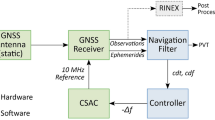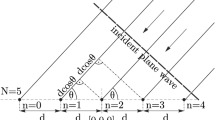Abstract
The timing performance of a Navigation with Indian Constellation (NavIC) receiver can be assessed by comparing it with a reference time standard. But it is difficult to do so if the time pulse of a standard clock is not accessible by any NavIC user. This paper proposes a novel method for this purpose that utilizes Precise Point Positioning (PPP) time transfer technique. The PPP time transfer technique utilizes products of the International GNSS Service (IGS) that are presently available only for GPS and GLONASS constellations. Therefore, though the PPP time transfer is an established technique, this cannot be directly used for NavIC timing as the IGS service has not yet been available for the NavIC constellation. So, in the proposed method, PPP time transfer technique has been utilized in an indirect way along with the access of BIPM time transfer data bank. This paper elaborates the basic principle and the experimental arrangement of the proposed technique. The uncertainty (1σ) of this measurement of NavIC receiver bias has been found to be 11 ns.





Similar content being viewed by others
References
D.W. Allan and M.A. Weiss, Accurate time and frequency transfer during common-view of a GPS satellite, 34th Annual Symposium on Frequency Control, USAERADCOM, Ft. Monmouth (1980) 334–346.
G. Petit and Z. Jiang, GPS All in View time transfer for TAI computation. Metrologia, 45 (2007) 35–45.
J. Kouba and P. Heroux, Precise point positioning using IGS orbit and clock products. GPS Solutions, 5 (2001) 12–28.
G. Petit, and Z. Jiang, Precise Point Positioning for TAI Computation, International Journal of Navigation and Observation, (2008) 1–8
GNSS Timescale Description IGS Time v1. https://www.unoosa.org/pdf/icg/2012/Timescale-IGS.pdf
P. Defraigne, W. Aerts and E. Pottiaux, Monitoring of UTC (k)’s using PPP and IGS real-time products. GPS Solutions, 19 (2015) 165–172.
G. Cerretto, P. Tavella, F. Lahaye, Y. Mireault and D. Rovera, Near real-time comparison and monitoring of time scales with precise point positioning using NRCan ultra-rapid products. IEEE Transactions on Ultrasonics, Ferroelectrics and Frequency Control, 59 (2012) 545–551.
Department of Space, Indian Space Research Organization, List of Navigation Satellites, https://www.isro.gov.in/spacecraft/list-of-navigation-satellites/
A. Santra, S. Mahato, S. Mandal, S. Dan, P. Verma, P. Banerjee and A. Bose, Augmentation of GNSS utility by IRNSS/NavIC constellation over the Indian region. Advances in Space Research, 63 (2019) 2995–3008.
A.A. Bhardwajan, A. Arora, S. Dakkumalla, T.S. Ganesh and B.N. Ramakrishna, Challenges in the system engineering of a Precise Timing Facility for NavIC. INCOSE International Symposium, 29 (2019) 302–313.
A. Arora, S. Dakkumalla, A.A. Bhardwajan, R. Sadasivan, S. Maharana, T.S. Ganesh and B.N. Ramakrishna, An in-house developed Timescale for NavIC PTF, European Navigation Conference (ENC). Warsaw, Poland (2019), pp. 1–6.
B.B. Gogoi, A. Kumar, M.V. Chandrasekhar, A. Kartik and S.C. Rathnakara, NavIC Time Transfer With Satellite Common View: An Analysis on Choosing Different Reference Times. Procedia Computer Science, 115 (2017) 87–93.
S. Mahato, A. Santra, S. Dan, P. Banerjee and A. Bose, An Experimental Study on Clock Stabilization of IRNSS-GPS-SBAS (IGS) Receiver. International Journal of Engineering Technology Science and Research, 4 (2017) 12.
Government of Canada, Precise Point Positioning, https://webapp.geod.nrcan.gc.ca/geod/tools-outils/ppp.php
Ionosphere free combination for dual frequency receivers, https://gssc.esa.int/navipedia/index.php/Ionosphere-free _Combination_for_Dual_Frequency_Receivers
IGS products, http://www.igs.org/products/
PPP data Files /ppp/xxxxyymm.gpi\, FTP server of the BIPM Time Department, ftp://ftp2.bipm.org/pub/tai/data/yyyy/time_transfer/
Leica GR50 and GR30, file:///C:/Users/user/Downloads/Leica_GR50_GR30_GNSS_Reference_Server_DS.pdf
Accord indigenous GNSS solution, http://accord-soft.com/pdfs/GNSS_profile.pdf
53200A Series RF/Universal Frequency Counter/Timers, https://www.keysight.com/us/en/assets/7018-02642/data-sheets/5990-6283.pdf
Y.S. Shmaliy, O. Ibarra-Manzano, L. Arceo-Miquel and J. Munoz-Diaz, An analysis of sawtooth noise in the timing SynPaQ III GPS sensor. Sensors & Transducers Journal, 79 (2007) 1151–1156.
Timing for VLBI, https://ivscc.gsfc.nasa.gov/meetings/tow2003/timing2003.pdf
K. Borsadiya, NavIC based Timing Applications in India, ICG-14 ISRO, Bengaluru (2019), https://www.unoosa.org/documents/pdf/icg/2019/icg14/19.pdf
A. A. Bhardwajan1, S. Dakkumalla1, A. Arora, T. S. Ganesh and A. Sen Gupta, Navigation with Indian Constellation and its Applications in Metrology, MAPAN-Journal of Metrology Society of India, 36(2021)227–236, https://doi.org/10.1007/s12647-021-00467-9
GPS Interface Specification, Navstar GPS space Segment/Navigation User Segment Interfaces (IS-GPS-200G) GPS Directorate (2012) 39
Acknowledgements
The authors acknowledge All India Council of Technical Education (AICTE), New Delhi (Project Code: File No 8-10/RIFD/RPS/ Policy-1/2016-17) and Defence Research and Development Organization (DRDO), New Delhi, India (Project Code: ERIP/ER/DG-MSS/990516601/M/01/1658) for financial support. They also acknowledge Space Application Center (SAC), Indian Space Research Organization (ISRO), Ahmedabad, India, Integrated Test Range (ITR), DRDO, Chandipur, India and Keysight Technologies, India for hardware support.
Author information
Authors and Affiliations
Corresponding author
Additional information
Publisher's Note
Springer Nature remains neutral with regard to jurisdictional claims in published maps and institutional affiliations.
Rights and permissions
About this article
Cite this article
Santra, A., Dan, S., Banerjee, P. et al. On Timing Performance of NavIC Receiver Through PPP Time Transfer Technique. MAPAN 37, 207–214 (2022). https://doi.org/10.1007/s12647-021-00528-z
Received:
Accepted:
Published:
Issue Date:
DOI: https://doi.org/10.1007/s12647-021-00528-z




